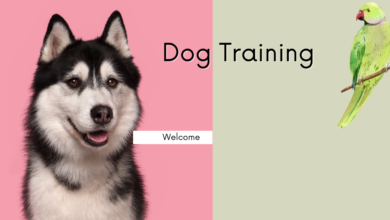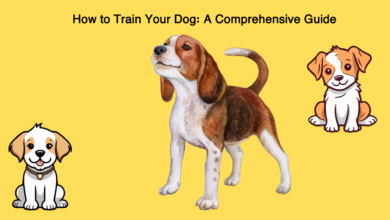
For pet owners who have mastered basic obedience training and are looking to take their pet’s skills to the next level, advanced training techniques offer a rewarding challenge. These techniques not only enhance your pet’s abilities but also strengthen the bond between you and your furry companion

Whether you’re interested in agility training, complex commands, or specialized tasks, advanced training can provide mental stimulation and physical exercise for your pet, while also deepening your understanding of their behavior and capabilities.
Understanding the Benefits of Advanced Training
Advanced training goes beyond teaching your pet basic commands like “sit,” “stay,” and “come.” It involves more complex tasks that require a higher level of focus, discipline, and communication between you and your pet. Here are some key benefits of advanced training:
- Mental Stimulation: Advanced training challenges your pet’s mind, keeping them mentally sharp and engaged. This is particularly important for intelligent breeds that may become bored with basic tasks.
- Physical Exercise: Many advanced training activities, such as agility or scent work, involve physical exercise. This helps keep your pet fit and healthy while also providing an outlet for their energy.
- Strengthened Bond: Advanced training requires close cooperation between you and your pet. As you work together to master new skills, the trust and communication between you will deepen, leading to a stronger bond.
- Improved Behavior: Advanced training reinforces good behavior and impulse control. It helps your pet learn to focus on tasks, follow complex instructions, and remain calm in challenging situations.
- Confidence Building: Successfully completing advanced tasks can boost your pet’s confidence. This is especially beneficial for shy or anxious pets, as it helps them gain a sense of achievement and self-assurance.
Advanced Training Techniques to Explore
If you’re ready to take your pet’s training to the next level, here are some advanced techniques to consider:
- Agility Training: Agility training is a popular advanced training activity that involves navigating an obstacle course. This includes jumps, tunnels, weave poles, and other challenges that require speed, coordination, and teamwork. Agility training is a great way to improve your pet’s physical fitness and mental sharpness.
- Scent Work: Scent work, also known as nose work, involves training your pet to locate specific scents. This can range from finding hidden treats to detecting specific objects or substances. Scent work taps into your pet’s natural instincts and provides excellent mental stimulation.
- Advanced Obedience Commands: Building on basic obedience, advanced commands might include tasks like “heel” without a leash, off-leash recall, or more complex cues like “place” (sending your pet to a specific spot and having them stay there). These commands require precision and focus, making them an excellent challenge for experienced pets.
- Clicker Training: Clicker training is a positive reinforcement technique that uses a clicker to mark the desired behavior, followed by a reward. This method is particularly effective for teaching complex behaviors, as it allows you to clearly communicate with your pet.
- Target Training: Target training involves teaching your pet to touch a specific object, such as a target stick or your hand, with their nose or paw. This technique can be used to teach a variety of behaviors, from moving to a specific location to performing tricks.
- Service Dog Tasks: If you’re interested in training your pet to assist with specific tasks, such as retrieving objects, opening doors, or providing comfort during stress, service dog training techniques can be adapted for your pet. These tasks require a high level of training and are particularly rewarding for both the pet and owner.
- Distance Commands: Training your pet to follow commands from a distance, such as “sit,” “down,” or “stay,” is an advanced skill that requires strong impulse control and understanding. This can be particularly useful in situations where your pet needs to obey commands from afar for safety reasons.
- Behavioral Shaping (continued): Shaping is a technique where you gradually mold a behavior by reinforcing successive approximations of the desired action. For instance, if you’re teaching your dog to roll over, you might start by rewarding them for lying down, then for shifting onto their side, and finally for completing the roll. This technique is effective for teaching complex behaviors in manageable stages.
- Trick Training: Advanced training is an excellent opportunity to teach your pet a variety of impressive tricks. From playing dead to spinning in circles or even fetching specific items by name, trick training can be both entertaining and stimulating for your pet. These tricks also help in reinforcing obedience and responsiveness.
- Behavioral Problem Solving: Advanced training can also be used to address and correct behavioral issues. For example, if your pet exhibits aggressive tendencies or fears, advanced techniques like counter-conditioning and desensitization can help modify these behaviors. Consulting with a professional trainer or behaviorist can provide tailored strategies for these challenges.
- Off-Leash Training: Mastering off-leash commands requires a high level of reliability and trust. Training your pet to respond to commands without a leash involves practicing in a controlled environment and gradually introducing more distractions. This level of training ensures your pet’s safety and reliability in various situations.
- Canine Freestyle: Often referred to as “dancing with your dog,” canine freestyle is a fun and creative way to bond with your pet while teaching them choreographed routines set to music. This advanced training technique incorporates obedience, tricks, and agility to create engaging performances.
- Search and Rescue Training: For those interested in more specialized training, search and rescue training can be an exhilarating challenge. This involves teaching your pet to locate and alert you to hidden objects or people. It’s a complex and rewarding training path that can enhance your pet’s problem-solving skills and teamwork.
- Canine Good Citizen Certification: The Canine Good Citizen (CGC) certification is an advanced obedience program recognized by the American Kennel Club (AKC). It includes a series of tests that assess a dog’s behavior in various situations. Achieving CGC certification demonstrates your pet’s advanced training and good manners.
- Agility Competitions: If your pet excels in agility training, participating in agility competitions can provide a great outlet for their skills. Competitions test your pet’s ability to navigate obstacles quickly and accurately, offering both a challenge and a chance to showcase their training.
Implementing Advanced Training Techniques
Successfully implementing advanced training techniques requires careful planning and consistent effort. Here are some tips to help you and your pet thrive in advanced training:
- Set Clear Goals: Define what you want to achieve with advanced training. Whether it’s mastering a new trick, improving obedience, or preparing for a competition, having clear goals will help guide your training sessions and measure progress.
- Break Down Complex Behaviors: For complex behaviors, break them down into smaller, achievable steps. This approach helps your pet understand what is expected and reduces the likelihood of frustration.
- Use Positive Reinforcement: Positive reinforcement is essential in advanced training. Reward your pet with treats, praise, or toys for correctly performing tasks or demonstrating desired behaviors. Avoid punishment, as it can lead to anxiety and hinder progress.
- Be Patient and Persistent: Advanced training can take time, and not every pet learns at the same pace. Be patient with your pet and persistent in your training efforts. Consistency and encouragement are key to success.
- Practice Regularly: Regular practice is crucial for reinforcing learned behaviors and skills. Schedule frequent training sessions and incorporate practice into your daily routine to maintain and improve your pet’s abilities.
- Manage Distractions: As your pet becomes more proficient, gradually increase the level of distraction in your training environment. This helps ensure that your pet can perform commands reliably in various settings.
- Seek Professional Guidance: If you encounter challenges or are unsure how to proceed with advanced training, consider consulting a professional trainer. They can provide expert advice, tailored training plans, and support to help you and your pet succeed.
Conclusion
Advanced training techniques offer a rewarding and stimulating experience for both experienced pet owners and their furry companions. By exploring activities like agility training, scent work, and advanced obedience, you can further enhance your pet’s skills and deepen your bond. Remember that successful advanced training relies on clear goals, positive reinforcement, and consistent practice. With dedication and patience, you can unlock your pet’s full potential and enjoy the many benefits of advanced training.




